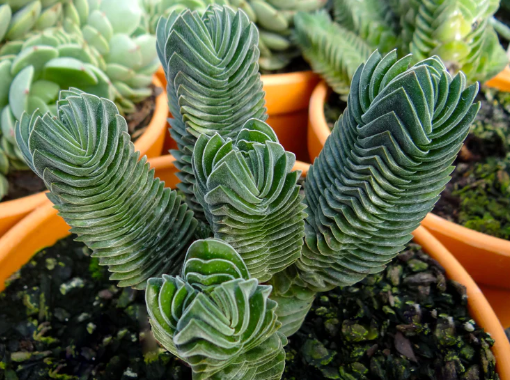
Crassula rupestris, commonly known as the Buddha’s Temple plant or Jade Necklace, is a succulent that belongs to the Crassulaceae family. This plant is native to South Africa, where it thrives in rocky habitats and arid regions. This succulent’s visual appeal lies in its architectural structure, which resembles the tiers of a pagoda or temple.
Appearance
- The Buddha’s Temple plant is a small, slow-growing succulent with compact, stacked leaves that resemble the tiers of a pagoda or temple.
- The columns grow up to 6 inches (15 cm) tall and up to 1.6 inches (4 cm) wide, producing branches from the sides. In other words, the leaves are tightly packed and form a columnar structure with architectural appearance.
- Leaves are flat, heart-shaped, silvery-grey to grayish-green, and covered with a powdery coating. They can take on reddish or bronze hues, especially when exposed to sunlight or stress conditions.
- While the primary attraction is the unique foliage, the Buddha’s Temple plant can produce small, star-shaped flowers in clusters. The flowers can be white or pale pink and appear at the tips of the stems during the flowering season.
Growth Habit
- The stems of this plant are often woody at the base, becoming more slender and green towards the top.
- This succulent has a branching habit and tends to grow vertically. When fully grown it forms a miniature tree-like structure. The growth rate is relatively slow.
Uses of The Plant
- Ornamental Gardens and Landscapes: Plant it in rock gardens, succulent beds, or use it as a focal point in garden designs.
- Container Gardening and Indoor Decor: Plant it in decorative pots or containers and place them on windowsills, shelves, or tabletops.
- Succulent Arrangements: Combine it with other succulents of varying shapes, colors, and sizes in the garden.
- Educational and Botanical Interest: In botanical gardens, educational institutions, or nature centers, the plant can be featured in exhibits or as part of educational programs to showcase the diversity of succulent plants.
Symbolism
- The tiered structure of the Buddha’s Temple plant is said to resemble a pagoda, a traditional Chinese tower-like structure often associated with spirituality, enlightenment, and protection.
- The plant’s growth pattern, with its upward-reaching structure, is associated with upward growth and progress. This aligns with the Feng Shui principles of promoting prosperity and abundance.
- In Feng Shui, placing the plant in prominent areas like the entrance of a home or office is believed to invite good luck and positive chi.
How To Grow And Care For Buddha’s Temple Plant
Soil and Container
Plant the Buddha’s Temple in a well-draining succulent or cactus mix. A mix that includes perlite or sand can help ensure proper drainage. If growing in a container, choose one with drainage holes to prevent waterlogging.
Sunlight Requirements
The Buddha’s Temple plant prefers bright, indirect light. When grown indoors, place the plant near a window where it can receive filtered sunlight.
Watering
Like many succulents, this plant prefers well-draining soil. Allow the soil to dry out between waterings to prevent root rot. Water sparingly during the growing season (spring and summer) and reduce watering in the dormant period (fall and winter).
Propagation
Propagation is commonly done through stem or leaf cuttings. Allow the cut ends to callus before planting them in well-draining soil. The plant is generally low-maintenance and doesn’t require frequent repotting.
Fertilizing
Feed the Buddha’s Temple plant with a balanced, water-soluble fertilizer during the growing season (spring and summer) at half the recommended strength. Avoid over-fertilizing, as succulents generally do not require heavy feeding.
Crassula Buddha’s Temple Plant Facts
| Scientific Name | Crassula rupestris |
| Common Names | Buddha’s Temple Plant, Jade Necklace |
| Family | Crassulaceae |
| Native to | South Africa |
| Hardiness Zone | USDA zones 9b to 11 |
| Size | Small, slow-growing |
| Growth Habit | Vertical, branching, pagoda-like structure |
| Leaf Color | Green, with potential for reddish or bronze hues |
| Sunlight Requirements | Bright, indirect light; can tolerate some direct sunlight |
| Watering | Allow soil to dry out between waterings; water sparingly |
| Soil Type | Well-draining succulent or cactus mix with perlite or sand |
| Container | Use containers with drainage holes to prevent waterlogging |
| Temperature | Not frost-tolerant; prefers temperatures above 50°F (10°C) |
| Propagation | Stem or leaf cuttings, allow cut ends to callus before planting |
| Toxicity | Generally non-toxic to humans and pets |
| Maintenance | Low-maintenance, slow growth, doesn’t require frequent repotting |
| Ornamental Use | Popular in succulent arrangements, dish gardens, and rock gardens |